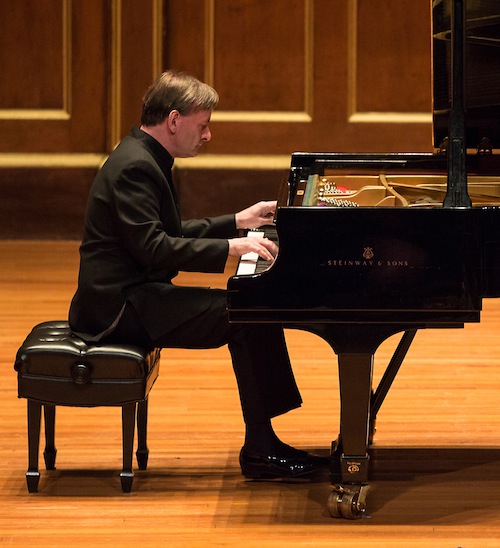Stephen Hough’s luminous artistry makes for memorable Chopin, Debussy

Stephen Hough performed a recital Friday night at Jordan Hall for the Celebrity Series. Photo: Robert Torres
No two composers transformed the sound of the piano quite like Chopin and Debussy. Chopin, ever the master of the spinning line, infused his melodies with the shimmering fioritura so characteristic of bel canto singing. And Debussy’s scores are saturated with the sounds of spacious harmonies and modal scales drawn from the far corners of history and the world’s musical cultures. But beyond new sonorities, their music shares an introspective style that manages to touch upon emotions and thoughts tucked deep in memory.
Friday night at Jordan Hall, in a concert sponsored by the Celebrity Series, pianist Stephen Hough offered a thoughtful and evocative program dedicated to the works of the two composers.
Hough plays with a crystalline technique and a fine musical sensitivity that makes him one of the foremost interpreters of the music of both composers. His tone is deep and pearly, even when he is called upon to play with a light, delicate touch.
Those aspects of his playing were immediately apparent in the opener, Debussy’s La plus que lente. The work is a silky waltz that has a touch of Chopin’s free-flowing style. Hough played the work with great freedom to the melody, with both hands moving slightly in and of sync to create a suspended sense of time. Colors were never lost as the pianist conjured a range of light and shade from the keyboard.
Debussy’s Estampes, which followed, was strikingly poetic. The phrases of “Pagodes” seemed to unfold in silvery sheets, the music a delicate impression of temples standing in the distance. The soft lines of “La soirée dans Grenade” wafted in the air like perfume. Tethering the cascading figures to the ground were habanera rhythms, which Hough rendered with sturdy motion. The rainstorm evoked in the third of the set, “Jardin sous la pluie,” began as a trickle before swelling to a deluge of piano filigree. Through it all, Hough played with clarity and sensitivity to the musical texture.
Chopin’s four Ballades are some of the composer’s most expressive and difficult works. Hough began his survey with the second of the set, rendering the opening theme in a quick tempo and the same light touch carried over from the Debussy pieces. The runs that emerge from the subsequent theme were given greater weight, aided by Hough’s left-hand figures. It was a spectacular display, though at times one wanted brighter tone from the right hand passages to match the trembling power of Hough’s left.
That was remedied in the first Ballade, which received golden treatment. Through tasteful rubato playing, the music ebbed and flowed in gentle waves. Hough’s reading of the third and fourth Ballades were dreamy and evocative of the Adam Mickiewicz poems upon which these pieces are supposedly based. The themes of the third sounded as if a dance. The hallmark of the fourth was the intricate counterpoint, which the pianist brought out in elegant detail.
Perhaps the most remarkable thing about Hough’s playing is his ability to shape a musical line from the most technical of passages. That was the case with his performance of Debussy’s Children’s Corner. Whether the running scales of “Dr. Gradus ad Parnassum,” the pentatonic meanderings of the “Serenade for the Doll,” or the skipping lines of “The Little Shepherd,” Hough found a distinctive sense of space and soft phrasing in each. The rhythms of “Golliwog’s Cakewalk” sounded with bustling energy, and the inverted Tristan theme that appears mid-movement was tender rather than schmaltzy.
Debussy’s L’isle joyeuse, which concluded the recital, was a sparkling affair. The pianist was in command of the work’s gnarly, rippling scales while again drawing attention to the work’ colors and musical line. The piece’s big theme, when heard the first time, was soft and spaciously phrased. When it returned in the conclusion, the pianist played it with splendor.
Warm applause brought Hough back for a series of encores. Some featured additional technical fireworks. Hough’s arrangement of “Dulcinea’s Variation” from Ludwig Minkus’s ballet score to Don Quixote was a brilliant tapestry of cascading figures. And the pianist-composer’s own Osmanthus Romp was entertaining with its side-winding riffs and passages that called for Hough to hammer the keys with an open palm.
But it was the first and last encores, Chopin’s Nocturne in F-sharp Op. 15, No. 2 and the Nocturne from Grieg’s Lyric Pieces, Op. 54, that returned the listeners to the lush sound worlds that characterized the entire evening.
Posted in Performances





Posted May 16, 2015 at 11:38 am by NICHOLAS DEUTSCH
“No two composers transformed the sound of the piano quite like Chopin and Debussy.” Well, maybe. But no ONE composer transformed the sound of the piano quite like Franz Liszt. Over more than half a century as a composer, in tandem with the evolving technology of the instrument, he expanded its expressive possibilities in extraordinary ways. Credit where credit is due, please. Thank you.